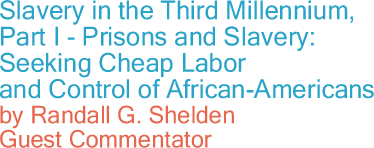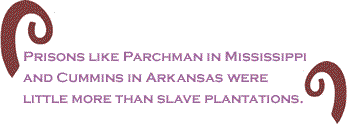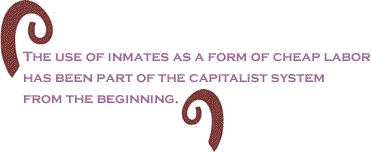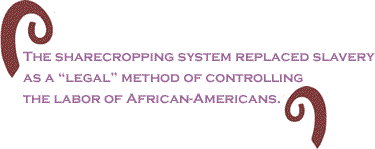
|
|||||||||||||||||||||
|
The winter, 2005 issue of Contexts (a leading sociology journal) featured a photo essay on the infamous Cummins Prison Farm in Arkansas. One photo showed about twenty convicts in a field picking cotton, while a white guard stood over them. Another photo showed a tractor pulling about 8 carts filled with convicts returning from the fields, with four guards riding on horses along the left side. The black and white photos could have easily been taken 100 years ago at one of several “plantation prisons” in the South. They were among about 5,000 photographs taken by sociologist Bruce Jackson between 1971 and 1975. Plantation prisons emerged in the southern states shortly after the end of the Civil War. Not surprisingly they were modeled after the slave plantation. Practically all of the prisoners were black, both male and female. They were sent to these prisons “on the flimsiest pretexts and then put to hard labor in the fields of these prisons, often in chain gangs.” Prisons like Parchman in Mississippi and Cummins in Arkansas were little more than slave plantations which, along with convict leasing, extended the slave system long after emancipation. Many of these prisons became notorious over the years, resulting in literally thousands of deaths. Perhaps the most infamous case came to light at the Tucker Prison Farm where a reform-minded warden named Tom Murton discovered numerous bodies of dead prisoners buried in the fields in the 1960s. The scandal created quite a stir at the time. Even a movie, Brubaker, starring Robert Redford was made about this scandal.
Throughout history those in power have sought to control groups that they perceived to be a threat and/or groups they wished to dominate for political or economic gain. The methods of control have varied from economic marginalization to thought control via propaganda to subjecting them to the control of the legal system to total or partial segregation and finally, in extreme cases, total extermination (e.g., genocide). In America such control has targeted Native Americans, African slaves, labor agitators and many others. It can also be said that the use of inmates as a form of cheap labor has been part of the capitalist system from the beginning, as owners seek to maximize profits however they can, including using the cheapest form of labor, whether it be slaves, immigrant labor, or inmates. In fact, taking advantage of those imprisoned (in various forms, including slavery) has been common among nations for centuries. Among the various forms of exploitation include the use of transportation, which was common up until the start of imprisonment in the early 19th century. Such a practice was developed by private merchant shippers in the 17th century and involved literally taking pardoned prisoners to North American plantations for a period of “indentured servitude.” It was one among many methods of amassing large fortunes during this time among certain capitalists, without having to resort to the so-called “free market.” It should be noted that most of these “indentured servants” were white, who were separated from black slaves (who were not among the convicted criminals at that time). The end of transportation coincided almost exactly with the increased use of slavery in Colonial America. Capitalists soon learned that there were even more benefits from the emerging African slave trade than white indentured servants. Among the many advantages of slaves was the fact that they “were held to perpetual instead of temporary servitude, they were cheaper to feed and clothe, they replaced themselves to some extent by natural breeding, and they endured the hot climate of the plantation much better than white men.” In America, slaves were important to the colonial economy (providing much needed cheap labor for a relatively small group of landowners); yet at the same time most whites thought of them as “savages” whom they feared. Laws were passed that perpetuated the slave economic system. The slaves were classified as chattel or property. When the Declaration of Independence was written and the statement that “all men were created equal” what they really meant was “all white men were created equal.” The emphasis here, of course was on “white” and “men,” since women were treated almost as if they were slaves. The white ruling class created an economic and political system, complete with a set of laws, that guaranteed slavery would remain intact.
As our standard history books have told us, constantly reinforced during our public school education, the slaves were “freed” after the Civil War ended. Well, not exactly. After the war the South was faced with some rather serious economic, political, and social problems. Political and economic recovery was among the first priorities because the economy of the South, based as it was on a slave mode of production, was being replaced by a capitalist mode of production. Another crucial problem was what to do with the newly “freed” slaves. What the white ruling class commenced to do was to begin the systematic oppression of blacks and maintain a system of caste rule that would replace a system of slavery. What happened was that the sharecropping system replaced slavery as a “legal” method of controlling the labor of African-Americans. A system of agricultural (and eventually industrial) “peonage” emerged and was supported by such informal methods as vigilantism, intimidation, Jim Crow laws and the like. What became known as convict leasing was a prime example. This topic is explored in Part II of this series. Randall G. Shelden is Professor of Criminal Justice at the University of Nevada-Las Vegas. He is the author and co-author of several books on crime and criminal justice, including Controlling the Dangerous Classes: a Critical Introduction to the History of Criminal Justice, Criminal Justice in America: a Critical View, Girls, Delinquency and Juvenile Justice and Youth Gangs in American Society. His latest book is Delinquency and Juvenile Justice in American Society, to be released this summer. A more detailed version of this series, complete with footnotes, is available on his web site: www.sheldensays.com. |
Your comments are always welcome. Visit the Contact Us page to send e-Mail or Feedback or Click here to send e-Mail to [email protected] e-Mail re-print notice
If you send us an e-Mail message we may publish all or part of it, unless you tell us it is not for publication. You may also request that we withhold your name. Thank you very much for your readership. |
| June 9 2005 Issue 141 |
|||||||||
|
|||||||||
|
|
|||||||||
| Printer Friendly Version | |||||||||
 |
|||||||||
 |
|||||||||
| |
|||||||||
| |
|||||||||



























